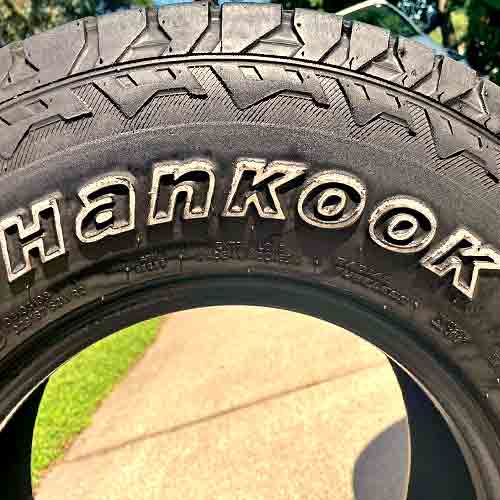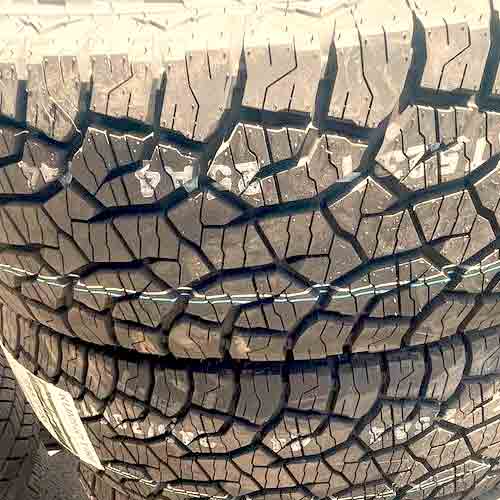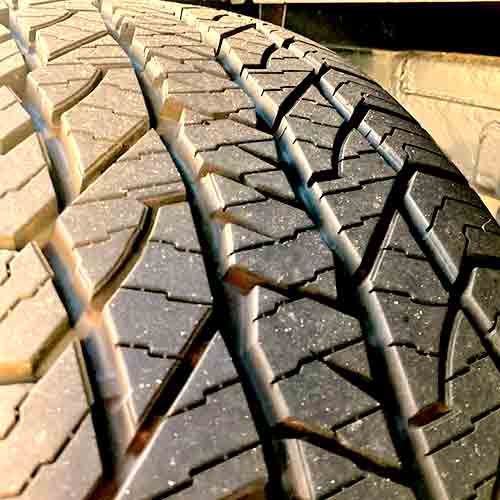Both the Kumho Road Venture AT52 and the Hankook Dynapro AT2 feature a bold and aggressive tread pattern designed for maximum grip and traction in all types of terrains. But which one will deliver better results for your needs? Let’s compare and see.

As a tire engineer, from my perspective, the Kumho AT52 performs better on wet and winter roads and provides greater comfort and fuel efficiency. In contrast, the Hankook Dynapro AT2 provides superior grip and steering response on dry roads and offers longer tread life. Moreover, it’s also great off-road, especially on mud and rocks, though it falls short on sand compared to its counterpart.
Table of Contents
Available Sizes
Starting with Hankook Dynapro AT2, this tire has following specs.
- Sizes: 15 to 22 inches
- Speed rating: S and T.
- Load Rating: SL to F.
- Weight: 29 to 80 lbs
- Tread depth: 12 to 16.4/32″
- Warranty: 60k miles for all
Detailed Review of Dynapro AT2: https://tiredriver.com/hankook-dynapro-at2-rf11-review/
On the other hand, Kumho Road Venture AT52 comes with following.
- Sizes: 15 to 22 inches (same as Dynapro).
- Speed ratings: Q, R, S and T.
- Load ratings: SL to F (again similar).
- Weight range: 30 to 63 lbs.
- Tread depth: 13 to 16/32″.
- Winter ratings: 3PMSF and M+S.
- Tread warranty: 50k miles for LT, and 55k for P metric.
Detailed Review of Kumho AT52: https://tiredriver.com/kumho-road-venture-at52-review/
Tread Features
The Kumho Road Venture AT52 is very much aligned towards performing on-road, just like its competitor. Let me discuss this tire’s tread from the middle first.

Kumho’s symmetric tread design gives you a 5-rib structure, featuring biters in the form of in-groove notches, sharp edges, and offset sides.
Its lugs in the middle may seem divided up, but they are joined together by reinforced foundations.
For example, the U-shaped blocks in the very middle may seem separated with lateral grooves, but they are both connected to each other, forming S-shaped blocks.
These provide on-road stability and, at the same time, traction off-road with their multiple biters.
Although the shoulder lugs are not as aggressive, as they don’t carry any notches and their outer margins are not properly serrated, you can say each lug is staggered on itself.
And since you also get thick enough N-shaped lugs on the sidewalls, the tire supplies ample lateral traction with lowered PSI (air pressure).
On the other side, the Hankook Dynapro AT2 also owns a 5-rib structure, with the innermost rib slightly wider and exhibiting notches facing in both directions. This way, the tire is able to provide both on and off-road traction.

Its notches provide off-road bite, and the wider central blocks with reinforced foundations underneath allow for above-average on-road stability and directional grip.
Moreover, the interlocking sipes, which go all the way deep, also have dual functions: they give you wet traction on roads, and off-road, they flex, opening up all the way and chewing into the ground, rendering traction.
The surrounding ribs, although they have these sipes along with offset edges, don’t provide you with notches.
Nonetheless, their spacious design allows for decent grip on all types of rugged terrains.
The same goes for the shoulders, though they are not staggered.
And with missing sidewalls, you can’t get enough out of them by lowering the pressure down.
Winter Performance
Typically all-terrain tires show up with amazing all-season capabilities. So, while these tires are great in summers, they also perform well on all types of snowy terrains, including ice and deeper tracks.
That’s why most of these tires are branded with 3 peak mountain snowflake ratings, and that includes both of our tires here.
However, considering their performance in all types of terrains, I would have to rate the Kumho Road Venture AT52 better.
The tire’s in-groove notches are actually very effective in grabbing snow particles, lodging them in the voids, and holding them there. This allows for this tire to have better contact with the ground with most of the lodged snow (it’s better than rubber-to-snow contact).
On the other hand, the Hankook Dynapro AT2 can’t offer as much snow-to-snow meet-up, mainly because of its stiffer composition, which is prone to getting harder even further with extreme negative winter temperatures.
Dry Traction
Evaluating the dry traction of an all-terrain tire requires considering both lateral and directional rolling capabilities. So, let’s take a closer look at both.
Dry Grip
The center of the tire’s tread is a crucial factor in determining its grip, as this is where the whole weight is centered, and maximum friction is produced.
That’s why both of these tires perform similarly with their equal footprint and longitudinally arranged ribs, allowing for better highway efficiency.
Though still, subjectively, the Kumho AT52 feels a little more stable overall (if you really have to pick one).
Dry Handling
Handling, also known as lateral traction, is a measure of a tire’s ability to corner.
Here, besides grip, it also depends on the tire’s steering response. In this performance area, the Hankook Dynapro AT2 takes the lead, thanks to its firmer tread foundations and a stiffer rubber composition.
As the tire corners, the lugs want to move/bend in the opposite direction (because of inertia).
With a firmer rubber-to-road connection, the Dynapro is less prone to that.
The Kumho Road Venture AT52, on the other hand, even though it’s a lighter tire, still pushes its lugs to flex more, causing slightly greater over and understeering, comparatively, and lacking in overall handling effectiveness.
Wet Traction
For the tire’s rubber to properly grip the road, water has to be cleared off from the tread in time, and this is done by grooves and sipes.
Both of these tread features are better structured on the Kumho Road Venture AT52.
The tire offers a better network of channels, allowing for better dispersing of water in all directions, and with its numerous biting edges and sipes, it clears off the leftover water particles more effectively as well.
The Hankook Dynapro AT2, on the other hand, although also features a lot of siping with an interlocking structure, its stiffer compound doesn’t allow them to have the needed flexibility.
Sipes need to be flexible to expand/contract to literally suck water particles in, and with a harder compound on the Dynapro, they don’t get to do that efficiently.
Fuel Consumption
The heavier the tire, the more energy it needs to move. It’s not rocket science.
And so, with a lighter overall structure, the Kumho Road Venture AT52 comes out on top (with its heaviest size only going up to 63 pounds, whereas its counterpart is seen with 80 lbs).
So comparatively, the Dynapro AT2 is lacking here.
On-Road Noise
Cabin noise is generated by many factors, including rolling friction, in-groove resonance, and air movement.
All of these factors explain why the Kumho Road Venture AT52 is louder comparatively (with a difference of 2 decibels).
First off, the tire has wider shoulder voids (relatively), which account for a larger flow of air (in and out of the tread). These air particles then hit the tread walls and generate higher noise levels.
Moreover, with a softer tread compound, the tire is also more susceptible to generating echoing in its tread (also called in-groove resonance), further adding to the overall noise pollution.
The Hankook Dynapro AT2, on the other hand, comes with a more packed-up design with voids having a greater angle.
This restricts the airflow much more, allowing for a quieter ride, comparatively.
Tread Life
Although both tires have their strengths, the Kumho Road Venture AT52, with its lower rolling resistance values, tends to wear off faster due to its relatively softer rubber composition.
On the other hand, the Hankook Dynapro AT2 not only shows a slower wear rate but also exhibits more even wear patterns over time, thanks to its more streamlined longitudinal structure, which offers better rolling capability on highways.
Durability
To tackle rough terrains with puncturing objects, both tires are equipped with powerful cut-resistant rubber and internal build.
However, the Hankook AT2 still provides superior protection with its 3-ply polyester casing, resulting in 3-ply sidewalls.
In comparison, the Kumho AT52 only comes with two-ply (reinforced casing with a single nylon cap ply), making it weaker.
Off-Road Performance
Off-road traction can vary greatly, but it becomes clearer when we examine each tire’s performance in different types of terrains.
Sand Performance
For enhanced traction on sand, tires are run with lowered PSI, allowing for better “floating” capabilities.
Additionally, factors such as weight and tread compound also play a significant role. Considering these, it’s understandable why the Kumho Road Venture AT52 is less prone to digging and better at moving forward.
The tire is lighter and has a smoother shoulder design, which helps with floating and prevents sinking. It also features sidewall lugs that spread out, increasing the overall footprint area in contact with the sand.
On the other hand, the Hankook Dynapro AT2, with its harder compound, stiffer sides (due to the 3-ply polyester casing inside), and heavier weight, is more susceptible to digging.
Mud Traction
Efficient mud traction requires tires with a higher void-to-tread ratio, allowing for efficient mud evacuation and reducing the risk of mud packing.
Unfortunately, both of these tires are not well-suited for all kinds of muddy tracks.
Their closed-up tread voids and longitudinally arranged lugs, sitting on continuous running ribs, restrict sideways evacuation of mud.
Rock Climbing Abilities
Durable sidewalls and a flexible tread are important characteristics for tires that can handle the challenges of rocky terrains.
Considering both tires, we get mixed results, and it’s hard to definitively say one is better than the other.
The Hankook Dynapro AT2 performs better with its 3-ply polyester casing, providing superior protection.
In contrast, the Kumho Road Venture AT52 offers a more flexible tread and sidewall lugs that provide superior overall climbing abilities with lowered air pressure.
Road Comfort
Although the Kumho AT52 lacks in offering a quiet enough ride, it still does better in the other half of the comfort performance.
And that has to do with its overall structural composition.
It not only features a softer tread compound on the outside but also a malleable structure in its internal construction.
Both of these account for a superior capacity to soak up bumps both on and off-road, resulting in a relatively smoother ride.
The Hankook Dynapro AT2, on the other hand, comes with a stiffer 3-ply polyester casing internally and a much harder compound on the outside, so the ride on these tires feels a lot bumpier.
Verdict?
The Kumho Road Venture AT52 is a better tire when it comes to wet road traction. The tire also features superior comfort and winter gripping capability.
On the other hand, the Hankook Dynapro AT2 excels in tread life and noise dampening on roads.
Off-road, it offers superior traction in rocky and muddy terrains, though it falls a bit short on sand due to its missing sidewall lugs.